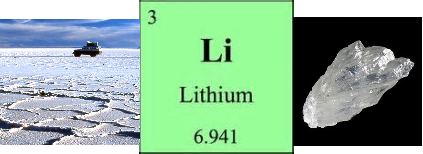Source: geology.com
Source: Geology.com
In the past, pegmatites were considered the only potential source of supply of lithium in South Africa. Spodumene, a member of the pyroxene–group (containing 3.73% Li), was considered the only potentially exploitable lithium-bearing mineral in South Africa.
In the Northern Cape and Northern Province, spodumene occurs in zoned pegmatites. In southern Kwazulu-Natal and in the south-eastern part of the Vredefort dome, spodumene occurs in unzoned pegmatites.
Northern Cape Province
The Namaqualand Metamorphic belt hosts various spodumene-bearing pegmatites, which is confined to the narrow east-west trending “pegmatite belt’ approximately 30km wide and 450km long.
Production of spodumene from the largest known mineralized pegmatite in Namaqualand totalled 1000 t. Grades were calculated at approximately 5 t spodumene per 100 t of pegmatite. (1865 ppm Li)
Lithium minerals including spodumene, amblygonite, lepidolite, zinnwaldite, petalite and triphylite-lithiophilite, are found in complex beryl-bearing pegmatites, concentrated in the western parts of the belt, north of Steinkopf.
Individual bodies range from over 2km long and 70m wide to small veinlets, and consist of coarse-grained quartz and feldspar with muscovite, tourmaline and garnet. Spodumene has been extracted from pegmatites on the following properties:
Spodumene Kop 1 and 2
Kokerboomrand 1 and 2
Groenhoekies
Norrabees 1 and 2Noumas
The Noumas Pegmatite was intermittently worked from 1925 to 1962 for: bismuth minerals, beryl, tantalum-columbite, muscovite, feldspar and spodumene. The 1 km long by 10 to 42 metres wide pegmatite was emplaced disconcordantly into foliated granodiorite. Spodumene crystals up to 1 m in length are characteristic of the 1 to 8 m intermediate zone, and accounts for up to 50% of the mineral assemblage in places.
Kwazulu-Natal Province
Spodumene in significant quantities has been identified in a number of leucocratic pegmatoid bodies on the farm The Corner 11328, south of Mzube River. The mineralized rocks form part of a suite of sub-concordant predominantly aplitic sills, which intruded mafic gneiss of the Mucklebtraes Formation, Margate Terrane. The entire package lies within a synformally folded klippen structure. The spodumene-bearing sills, which are the most consistently and well mineralized, are called the Highbury Pegmatites. The sills are up to 15m thick and were emplaced at several structural levels along the northern limb of the synform. The white coarse-grained rocks are composed of quartz, albite, microcline and spodumene with traces of white lithium mica, garnet, graphite and rarely beryl. Pale yellowish green to pink spodumene intergrown with quartz, forms irregular to ovoid poikilocrysts up to 40cm across. This texture is characteristic of spodumene that has replaced primary petalite. Outcrops with more than 35% intergrown quartz have been recorded intermittently over a 1km strike length. The down-dip extent of the mineralized zone cannot be calculated with the present data and drilling is necessary to establish a reliable resource estimate. The Li–pegmatites are considered to be late-stage differentiates of the characteristically anhydrous garnet leucogranites and charnockites of the Margate Suite, with which they share many geochemical and mineralogical similarities. The lithium may have been leached form country rock metasediments during anatexis. A simple gravimetric test have shown that spodumene can be efficiently beneficiated to a product of ~7% Li2O with total iron content expressed as Fe2O3 of ~0.38%
- Pella Resources Ltd has a prospecting license covering the Highbury pegmatites in KwaZulu-Natal and drilling was in progress in 2017.



